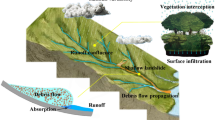Abstract
The factors of the debris flow and debris flood (debris flow-flood) occurrence on 11 August 2001 on the active Nam Ko alluvial fan in Phetchabun province, central Thailand, were studied. Evidences of past activity registered in the alluvial fan, and the debris flow-flood event were reconstructed. The disastrous debris flow-flood event was not the work of the unusual high amount of rainfalls alone, as previously theorized, but is a work of combined factors from the terrain characteristics with specific land covers to the time delay for accumulation of debris and sediments. This combination of factors could lead to a debris flow-flood after a high amount of precipitation. The process could also be worse if a landslide formed a natural dam, then the dam was destroyed under the weight of impounded water. After such a disastrous event, it would take time for more plant debris and sediments in the sub-catchment area to accumulate before the next debris flow-flood.























Similar content being viewed by others
References
Beverage JP, Culbertson JK (1964) Hyperconcentrations of suspended sediment: American Society of Civil Engineers. J Hydraul Div 90(HY6):117–126
Cannon SH (1997) Evaluation of the potential for debris and hyperconcentrated flows in Capulin Canyon as a result of the 1996 Dome Fire, Bandelier National Monument, New Mexico. U.S. Geological Survey open file report, pp 97–136
Costa JE (1988) Rheologic, morphologic, and sedimentologic differentiation of water floods, hyperconcentrated flows, and debris flows. In: Baker VE, Kochel CR, Patton PC (eds) Flood geomorphology. Wiley, New York, pp 113–122
Costa JE, Jarrett RD (1981) Debris flow in small mountain channels of Colorado and their hydrologic implication. Bull Assoc Eng Geol XVIII(3):309–322
Dai FC, Lee CF, Li J, Xu ZW (2001) Assessment of landslide susceptibility on the natural terrain of Lantau Island, Hong Kong. Environ Geol 40(3):381–391
Giraud RE (2002) Guidelines for the geological evaluation of debris-flow hazards on alluvial fan. Rocky Mountain Geological Society 54th Annual Meeting May 7–9, 2002, Cedar City, Utah
Miyajima S (2001) Debris flow studies in Japan. In: Tianchi L, Chalise SR, Upreti BN (eds) Landslide hazard mitigation in the Hindu Kush-Himalayas, International Center for Integrated Mountain Development, Kathmandu, pp 215–228
National Research Council (1982) Selecting a methodology for delineating mudslide hazard areas for the National Flood Insurance Program. National Academy Press, Washington DC
National Research Council (1996) Alluvial fan flooding. Committee on alluvial fan flooding, National Academy Press, Washington DC, pp 172
Pierson TC, Costa JE (1987) A rheologic classification of subaerial sediment-water flows. In: Costa JE, Wiezorek GF (eds) Debris flows/avalanches. Geological Society of America, Reviews in Engineering Geology, vol VII, pp 1–12
Van Westen JV (1994) GIS in landslide hazard zonation :a review, with examples from the Andes of Columbia. In: Mountain environments and geographic information systems. Taylor & Francis, London, pp 136–165
Varnes DJ (1984) Landslide hazard zonation: a review of principles and practice natural hazards UNESCO, France, vol 3
Wieczorek GF, Ellen S, Lips EW, Cannon SH, Short DN (1983) Potential for debris flow and debris flood along the Wasatch Front between Salt Lake City and Willard, Utah, and measures for their mitigation. U.S. Geological Survey open file report, pp 83–635
Acknowledgements
The Graduate School of Chulalongkorn University and the Ministry of Interior provided a partial funding for this study. Dr. Nopadon Muangnoicharoen of Chulalongkorn University and Dr. Kittitep Fuangkhajorn of Suranaree University of Technology critically reviewed the concepts of this research. The technical supports were provided by the staff of Geo-Informatics Center for Thailand (GISTHAI) of Chulalongkorn University and the staff of Geo-mechanical Research Unit, Suranaree University of Technology.
Author information
Authors and Affiliations
Corresponding author
Rights and permissions
About this article
Cite this article
Yumuang, S. 2001 debris flow and debris flood in Nam Ko area, Phetchabun province, central Thailand. Environ Geol 51, 545–564 (2006). https://doi.org/10.1007/s00254-006-0351-9
Received:
Accepted:
Published:
Issue Date:
DOI: https://doi.org/10.1007/s00254-006-0351-9




